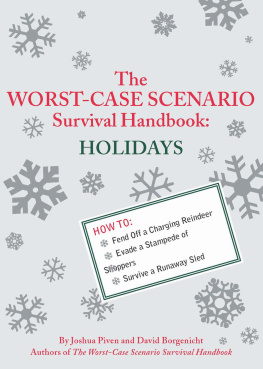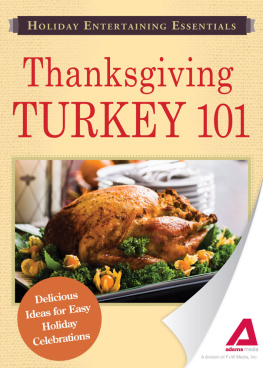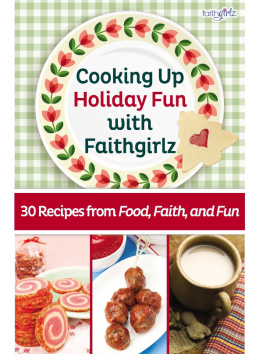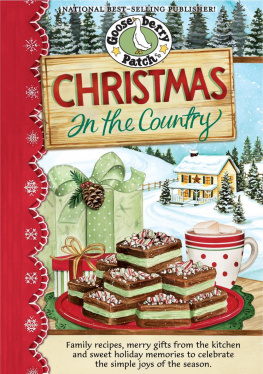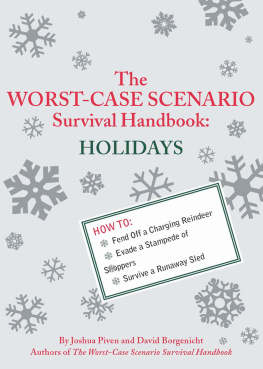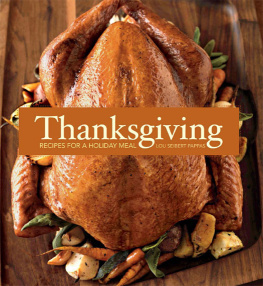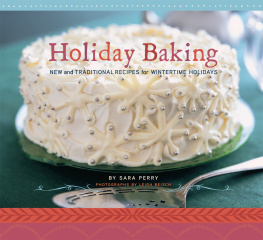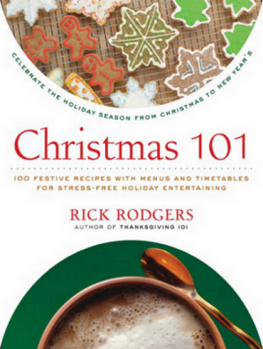The
WORST-CASE SCENARIO
Survival Handbook:
Holidays
By Joshua Piven and David Borgenicht
Illustrations by Brenda Brown

When a life is imperiled or a dire situation is at hand, safe alternatives may not existand elves are not always around to help out. To deal with the holiday worst-case scenarios presented in this book, we highly recommendinsist, actuallythat the best course of action is to consult a professionally trained expert. But because highly trained professionals may not always be available when the safety or sanity of individuals is at risk, we have asked experts on various subjects to describe the techniques they might employ in these seasonal emergency situations. The publisher, authors, and experts disclaim any liability from any injury that may result from the use, proper or improper, of the information contained in this book. All the information in this book comes directly from experts, but we do not guarantee that the information contained herein is complete, safe, or accurate, nor should it be considered a substitute for your good judgment, your common sense, or your sense of peace on earth and goodwill toward men. And finally, nothing in this book should be construed or interpreted to infringe on the rights or presents of other persons or to violate criminal statutes; we urge you to obey all laws and respect all rights, including property rights, of others.
The Authors
You better watch out
Santa Claus Is Coming to Town
The world thinks of the Holidays as a time of peace and joya time when all is harmonious, and we all join together eating, drinking, and generally being merry. We give gifts, we donate to charities, we spend time with our friends and loved oneswhat could possibly go wrong?
Consider this: More suicides, car accidents, family arguments, and food and alcohol poisonings take place during the months of November and December than any other time of the year. Add travel mishaps, kitchen disasters, snow- and ice-related injuries, electrocutions, tree-trimming catastrophes, and gift-related traumastheres no such thing as a silent night when it comes to the holidays.
You may not be able to control Mother Nature, acts of God, mischievous elves, or bad cooks. But you can plan ahead to make sure that youre ready to act when your holiday plans take an unscheduled dive.
We sincerely hope that the worst that awaits you this holiday season is merely a minor mishapa slightly overcooked turkey, a precariously balanced Christmas tree, or an unwanted gift. But in case tidings somewhat less comforting and joyful come your way, we want you to be prepared.
And so, as we did with our other Worst-Case Scenario Survival Handbooks, weve consulted dozens of highly trained professionals to come up with clear, step-by-step instructions for how to survive the perils of cooking and entertaining, friends and family, shopping, and assorted emergencies indoors and in the great outdoors. We spoke with chimney sweeps, physics professors, wilderness survival instructors, travel journalists, neurologists, craftmakers, professional carolers, gift consultants, motivational speakers, veterinarians, dentists, etiquette instructors, and dozens of others to obtain the responses to the worst worst-case scenarios we could imagine.
From how to extinguish a grease fire to how to fend off a charging reindeer, from how to deal with a run-away parade balloon to how to safely fall from a ladder, and from how to repurpose a fruitcake to how to make an emergency menorah, this handy guide should keep you safe and soundat least between the end of November and New Years Day. In a useful appendix, weve also included a New Years Resolution-O-Matic and a sample There is no Santa Claus speech.
Being prepared is the best present you can give othersor yourself. (This book will fit in every stocking and under every tree.) With this guide in hand, you will be all set. So relax and enjoy the holidays. We hope that all your wishes come true and that your scenarios are best-case scenarios. But dont count on it.
The Authors
CHAPTER 1
COOKING AND
ENTERTAINING
1. Close the oven and broiler doors.
Turn the oven off.
2. Open nearby windows.
Smoke will pour out of the oven vent. Turn the vent-fan in the hood above the stove to its highest setting and open windows to help clear smoke. If possible, close the doors to the kitchen to contain the smoke. If you cannot close off the kitchen, open as many other windows in the building as possible to establish cross-ventilation.

3. Wait five minutes.
Ovens are designed for high heat, so it should contain the fire without a problem. Keep the oven door closed to avoid adding oxygen to the fire.
4. Open the oven door slightly.
Keep your face well back from the oven when you open the door. After five minutes, the turkey fire should have burned itself out. If it is still burning, close the door immediately and wait several minutes before opening it again. If the fire continues to burn for more than 10 minutes, call the fire department.
5. Remove the burned bird.
Use caution: It will be extremely hot. Place the bird on a cutting board or platter. Wait at least 10 minutes before touching the turkey or attempting to rescue the meat. Often only the skin and fat will be burned. (See How to Serve Burnt Turkey).
Be Aware
- Oven fires can usually be extinguished without help from the fire department. However, oven seals may fail in a high-heat fire, causing the fire to spread to surrounding areas. Have someone standing by the phone to call for help if needed.
- Do not attempt to pull a flaming turkey out of the oven: You risk grease burns on your arms and face.
- Do not attempt to smother a flaming turkey while it is in the oven. The high temperatures and flaming grease may ignite the material.
- Do not attempt to douse the fire by throwing flour, baking soda, gravy, or any other products on a flaming turkey. These may be combustible and may cause grease to spatter. Using a fire extinguisher will render the bird inedible.
1. Remove the skin and charred sections.
Discard these burned parts.
2. Slice the turkey.
3. Pick out the scorched pieces.
Usually the burned portion will be white (breast) meat, which has less fat. Discard it.
4. Check the dark meat.
Some dark meat may also be severely overcooked. Pick out the moist sections and put them on a platter that has been warmed in the oven. Cover and set aside.
5. Moisten dry dark meat.
Layer the salvaged but dry dark meat in a roasting pan. Soak it with several cups of chicken broth and melted butter. Cover it with a cloth and put it in a warm oven (make sure the oven is turned off). Let the meat rest for a few minutes. Drain and remove meat from pan and place on serving tray. Do not use a microwave to warm the meat or the meat will toughen.
6. Fatten the gravy.
Add one stick of butter to a boiling pot of gravy, let the butter melt, and allow the gravy to cool to serving temperature. Pour the mixture over the turkey after it has been carved.

